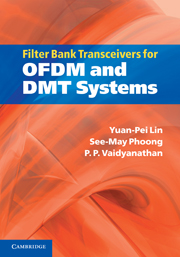Book contents
- Frontmatter
- Dedication
- Contents
- Preface
- 1 Introduction
- 2 Preliminaries of digital communications
- 3 FIR equalizers
- 4 Fundamentals of multirate signal processing
- 5 Multirate formulation of communication systems
- 6 DFT-based transceivers
- 7 Precoded OFDM systems
- 8 Transceiver design with channel information at the transmitter
- 9 DMT systems with improved frequency characteristics
- 10 Minimum redundancy FIR transceivers
- A Mathematical tools
- B Review of random processes
- References
- Index
8 - Transceiver design with channel information at the transmitter
Published online by Cambridge University Press: 05 August 2015
- Frontmatter
- Dedication
- Contents
- Preface
- 1 Introduction
- 2 Preliminaries of digital communications
- 3 FIR equalizers
- 4 Fundamentals of multirate signal processing
- 5 Multirate formulation of communication systems
- 6 DFT-based transceivers
- 7 Precoded OFDM systems
- 8 Transceiver design with channel information at the transmitter
- 9 DMT systems with improved frequency characteristics
- 10 Minimum redundancy FIR transceivers
- A Mathematical tools
- B Review of random processes
- References
- Index
Summary
From Chapter 6, we know that an OFDM system converts an LTI channel into a set of parallel subchannels. When the channel is frequency-selective, these subchannels can have very different subchannel gains. The system performance can be severely limited by a few bad subchannels. One solution to this problem is to use a precoder as demonstrated in Chapter 7. In many applications, the transmission environment does not change frequently. These applications include most wired transmission schemes, such as ADSL and VDSL systems, and many wireless transmission schemes, such as fixed wireless access systems and wireless LAN system where the end users are not mobile. Under these environments, if the channel state information is known at the transmitter, one can exploit this information to carry out bit allocation. By optimally assigning the bits to the subchannels, the system performance can be substantially improved, especially when the channel is highly frequency-selective. In this chapter, we will derive the optimal zero-forcing transceivers when there is bit allocation at the transmitter.
Zero-forcing block transceivers
The DFT-based transceivers studied in Chapter 6 employ either DFT or IDFT operations at the transmitter and receiver. The filter bank formulation shows that their polyphase matrices are constant matrices related to the DFT/IDFT operations. In this chapter, we study general block transceivers where the polyphase matrices can be arbitrary constant matrices. Figure 8.1 shows a block transceiver system. The M × 1 input vector s is processed by the N × M transmitting matrix G0 to produce an N × 1 output vector
х = G0s.
which is converted to a sequence x(n) and transmitted over the channel. At the receiver, the received sequence is blocked into vectors of size N. The N × 1 received vector r is then processed by the M × N receiving matrix So to obtain the M × 1 output vector
ŝ = S0r.
- Type
- Chapter
- Information
- Filter Bank Transceivers for OFDM and DMT Systems , pp. 223 - 258Publisher: Cambridge University PressPrint publication year: 2010



